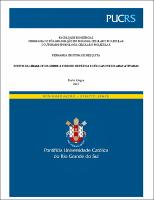| Share record |


|
Please use this identifier to cite or link to this item:
https://tede2.pucrs.br/tede2/handle/tede/7593| Document type: | Tese |
| Title: | Efeito da liraglutida sobre a fibrose hepática e células estreladas ativadas |
| Author: | Mesquita, Fernanda Cristina de  |
| Advisor: | Oliveira, Jarbas Rodrigues de |
| Abstract (native): | A fibrose hepática é a resposta cicatricial do fígado à lesões repetidas. Este processo inicia com o dano das células parenquimatosas e consecutiva inflamação, caracterizado pelo rompimento da arquitetura hepática associada ao aumento da expressão dos componentes da matriz extracelular. O desenvolvimento da fibrose hepática é baseado na ativação das células hepáticas estreladas (HSC) que sofrem mudanças fenotípicas e se caracterizam pela perda do depósito de vitamina A e aumento da proliferação celular, desencadeando disfunção microcirculatória hepática e fibrogênese nos pacientes com doença hepática crônica (CLD). A liraglutida é um análago do GLP-1 (glucagon-like peptide 1) bem estabelecido como fármaco antidiabético, mas que também possui propriedades antinflamatórias, além da efetividade para NAFLD (doença hepática gordurosa não alcoólica). Por essa razão, o objetivo deste estudo foi avaliar os efeitos da liraglutida sobre o fenótipo das HSC e a função microvascular hepática utilizando diversos modelos pré-clínicos de CLD. Os resultados obtidos demonstram que a liraglutida desativou o fenótipo das HSC humanas e de ratos através de um mecanismo independente do receptor GLP1. A liraglutida não afetou a viabilidade das HSC mas diminuiu a proliferação celular. Os ratos com CLD que receberam liraglutida apresentaram pressão portal significativamente menor (-20%) com consequente redução da resistência vascular intra-hepática. Houve também uma acentuada melhoria na função vascular hepática, fibrose, fenótipo das HSC e fenótipo endotelial sinusoidal. Os efeitos anti-fibróticos da liraglutida também foram confirmados em tecido hepático humano. Como conclusão, este estudo demonstra pela primeira vez que a liraglutida melhora o endotelio sinusoidal hepático em modelos experimentais clinicamente relevantes de cirrose, o que leva a melhora no quadro fibrótico e na hipertensão portal e, portanto, pode ser válido no tratamento da doença hepática crônica avançada. |
| Abstract (english): | Liver fibrosis is the wound healing response to repeated injury of the liver. This process begins with the damage of the parenchymal cells and subsequent inflammation, characterized by the rupture of the hepatic architecture associated to the increase of the expression of the components of the extracellular matrix. The development of hepatic fibrosis is based on the activation of hepatic stellate cells (HSC) that undergo phenotypic changes and are characterized by loss of vitamin A deposition and increased cell proliferation, triggering hepatic microcirculatory dysfunction and fibrogenesis in patients with chronic liver disease (CLD). Liraglutide is a GLP-1 agonist (glucagon-like peptide 1) well established as an antidiabetic drug, but also has anti-inflammatory properties, in addition to the effectiveness for NAFLD (non-alcoholic fatty liver disease). Therefore, the aim of this study was to evaluate the effects of liraglutide on the HSC phenotype and liver microvascular function using diverse pre-clinical models of CLD. The results obtained demonstrate that Liraglutide de-activated human and rat HSC phenotype through a GLP1-Rindependent mechanism. Liraglutide did not affect the HSC viability but decreased cell proliferation. CLD-rats receiving liraglutide exhibited significantly lower portal pressure (-20%) with a consequent reduction in intrahepatic vascular resistance. There was also a marked improvements in hepatic vascular function, fibrosis, HSC phenotype and sinusoidal endothelial phenotype. The anti-fibrotic effects of liraglutide were confirmed in human liver tissue. In conclusion, this study demonstrates for the first time that liraglutide improves hepatic sinusoidal endothelium in clinically relevant experimental models of cirrhosis, which leads to improvement in fibrosis and portal hypertension, and therefore is valid in the treatment of advanced chronic liver disease. |
| Keywords: | Cirrose Hipertensão Portal HSC LSEC GLP-1R Liraglutida |
| CNPQ Knowledge Areas: | CIENCIAS BIOLOGICAS::BIOLOGIA GERAL |
| Language: | por |
| Country: | Brasil |
| Publisher: | Pontifícia Universidade Católica do Rio Grande do Sul |
| Institution Acronym: | PUCRS |
| Department: | Faculdade de Biociências |
| Program: | Programa de Pós-Graduação em Biologia Celular e Molecular |
| Access type: | Acesso Aberto |
| Fulltext access restriction: | Trabalho será publicado como artigo ou livro |
| Time to release fulltext: | 24 meses |
| Date to release fulltext: | 28/07/2019 |
| URI: | http://tede2.pucrs.br/tede2/handle/tede/7593 |
| Issue Date: | 17-Mar-2017 |
| Appears in Collections: | Programa de Pós-Graduação em Biologia Celular e Molecular |
Files in This Item:
| File | Description | Size | Format | |
|---|---|---|---|---|
| TES_FERNANDA_CRISTINA_DE_MESQUITA_COMPLETO.pdf | FERNANDA_CRISTINA_DE_MESQUITA_TES | 3.62 MB | Adobe PDF |  Download/Open Preview |
Items in DSpace are protected by copyright, with all rights reserved, unless otherwise indicated.




